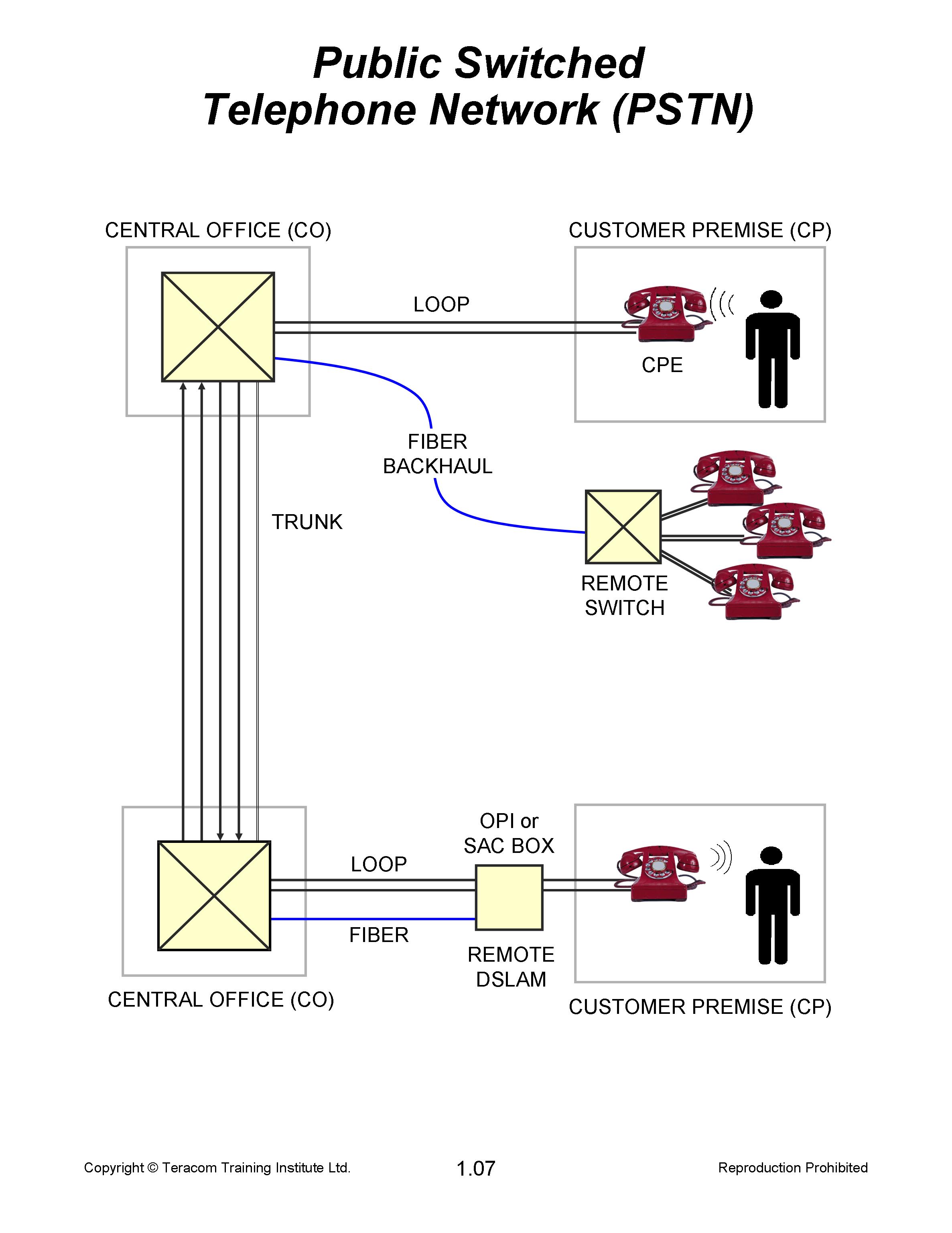Introduction
In this tutorial, we'll understand the Public Switched Telephone Network (PSTN), and the basics of Plain Ordinary Telephone Service (POTS).
To be clear, this tutorial is on legacy technology, i.e., installations left to us by those who are now gone. Going forward, the copper-wire access loops discussed in this tutorial are completely replaced with fiber to the home, usually in Passive Optical Network configuration.
Though fiber, Voice over IP, SIP and broadband Internet will eventually completely replace all of the PSTN and POTS technologies including circuit-switching, channels and analog, most of the technologies developed and equipment deployed in the 20th century - the installed base - was for POTS. For this and a number of other reasons listed at the end, understanding POTS and the PSTN remains one of the cornerstones of a complete understanding of telecom.
This lesson is part of:
- Instructor-led Course 101 Broadband, Telecom, Datacom and Networking for Non‑Engineers
- Online CTNS Certification Course 2201 The PSTN
- Online CTA Certification Course 2241 Fundamentals of Telephony and Voice over IP
- Telecom 101 Textbook (softcover, hardcover and Amazon, Google and Apple eBook)
- CTNS Study Guide

Congratulations, you found an EASTER EGG, a hidden gift!
This easter egg is 90% off online CTNS Course 2201 The PSTN,which covers this tutorial and many other aspects of the POTS and the PSTN, including analog and the voiceband.
Click here and use coupon 1359 to get the full Course 2201 The PSTN for $11.90 instead of $119!
The PSTN
We begin with a basic model for the telephone network, and build on it in subsequent discussions. At the top of the diagram, we have a telephone and a telephone switch. The telephone is located in a building called a Customer Premise (CP), and the telephone switch is located in a building called a Central Office (CO). One could refer to the telephone as Customer Premise Equipment (CPE).

The telephone is connected to the telephone switch with two copper wires, often called a local loop or a subscriber loop, or simply a loop. This a dedicated access circuit from the customer premise into the network. We usually have the same arrangement at the other end, with the far-end telephone in a different customer premise and the far-end telephone switch usually in a different central office.
The maximum allowed resistance dictates a maximum length for the local loop, which is usually 18,000 feet – about three miles or five kilometers. Copper is a good conductor of electricity - but not perfect: it has some resistance to the flow of electricity through it. Because of this, the signals on the loop diminish in intensity or attenuate with distance… if the loop were too long, you wouldn't be able to hear what the other person was saying. Thus, COs traditionally had a serving area of three miles radius around them, about 27 square miles or 75 km2.
With suburban sprawl, we couldn't build COs every five miles, so in practice, new subdivisions were served from remote switches, which are low-capacity switches in small huts or underground controlled environment vaults. The remote provides telephone service locally on the loops in the subdivision. The backhaul connects the remote switch back to the nearest CO via fiber.
Other equipment that is part of the outside plant includes remote DSLAMs, the device containing the network-side modems that customer modems communicate with, housed in an enclosure by the side of the road. Often, existing Outside Plant Interface (OPI) or Serving Area Concept (SAC) boxes, initially installed as wiring junction boxes, were augmented to house the remote DLSAM.
The backhaul for these devices is fiber - plus copper wires carrying electricity to power the DSLAM.
Telephone switches were historically connected with trunks. While subscriber loops are dedicated access circuits from the customer premise to the CO, trunks are shared connections between COs.
To establish a connection between one customer premise and another, the desired network address (telephone number) is signaled by the customer to the switch over their loop, the switch selects an unused trunk circuit going in that direction and reserves it, called seizing the trunk, then connects the caller's loop to that trunk, for the duration of the call.
When one end or the other hangs up, the trunk is released for someone else to connect between those two COs.
This method for sharing the trunks is known as circuit switching. The generic name of the service sold by telephone companies that implements this is Plain Ordinary Telephone Service (POTS).
In systems installed up until about 2000, trunks were carried using channelized fiber optic transmission systems. A channel is a reserved fraction of the capacity of the transmission system, 64 kb/s, called a Digital Service Level Zero or DS0 for short.
The caller's voice would be carried from one end to the other at 64 kb/s over reserved DS0 channels. This happens in both directions at the same time, and 64 kb/s is transmitted whether the caller is speaking or not.
Transition to The All-IP Network
The new-generation all-IP network moves IP packets, as needed, not using reserved channels, and the telephones communicate packets directly one to another once a call is set up. The new generation uses SIP messages to set up calls; legacy systems use variations of the ISDN call control message set.
The transition between the two plans, channels and packets, is and will be a long process.
For obvious business reasons, telephone companies do not replace equipment just because something new comes along. There are still many CO switches that perform the previous technique, circuit switching.
To keep operating the "old" circuit switch with the "new" IP backbone, a Packet Voice Gateway is installed between the switch and the transmission network, transcoding between packets and channels, and between the different call control messages used on each side.
To keep operating "old" channelized transmission systems with the "new" IP backbone, all of the channels are combined together to make one high-speed channel, used all at once to connect routers at each end, which communicate packets to each other.
Why Knowledge of POTS and the PSTN Remains Part of a Complete Understanding of Telecom
Though fiber, Voice over IP, SIP and broadband Internet will eventually completely replace POTS and PSTN technologies, it's not hard to come up with a list of reasons why knowing the basics of the PSTN and POTS is still required:
- There are hundreds of millions of POTS lines still in service, still being maintained and still generating revenue for carriers. This will not disappear overnight, but will continue to be supported for many years to come, until the last POTS line is finally disconnected.
- Broadband Internet service is provided using DSL modems over the wires put in place for POTS.
- Even if we were to move to an all-Voice-over-IP network, at least the last foot will still be analog: at residences, a cable modem or fiber terminal performs the functions of a POTS line card: power, dial tones, ringing and analog signals to regular phones via the telephone wires inside the house.
- At a business, the analog-digital conversion and packetization happen inside a VoIP telephone plugged onto the LAN - but the signals on the curly cord attached to the handset are analog.
Many VoIP systems digitize voice at 64 kb/s, a bit rate that is directly related to the voiceband defined for analog POTS. Legacy SONET and SDH fiber-optic transmission infrastructure are organized into 64 kb/s channels. - There is a huge inertia of regulations, tariffs, accounting and money involved in the interconnect between local exchange carriers (the "last mile"), and inter-exchange carriers, (the "long distance"), that is based on Tandem Access Trunks, which is channelized PSTN circuit-switched technology.
- Understanding channels and circuit-switching is necessary to know how a phone call from a cellphone on a wireless network connects to a phone plugged into a competitor’s cable modem in another city!
So POTS remains part of the fundamental knowledge set in the telecommunications business.










